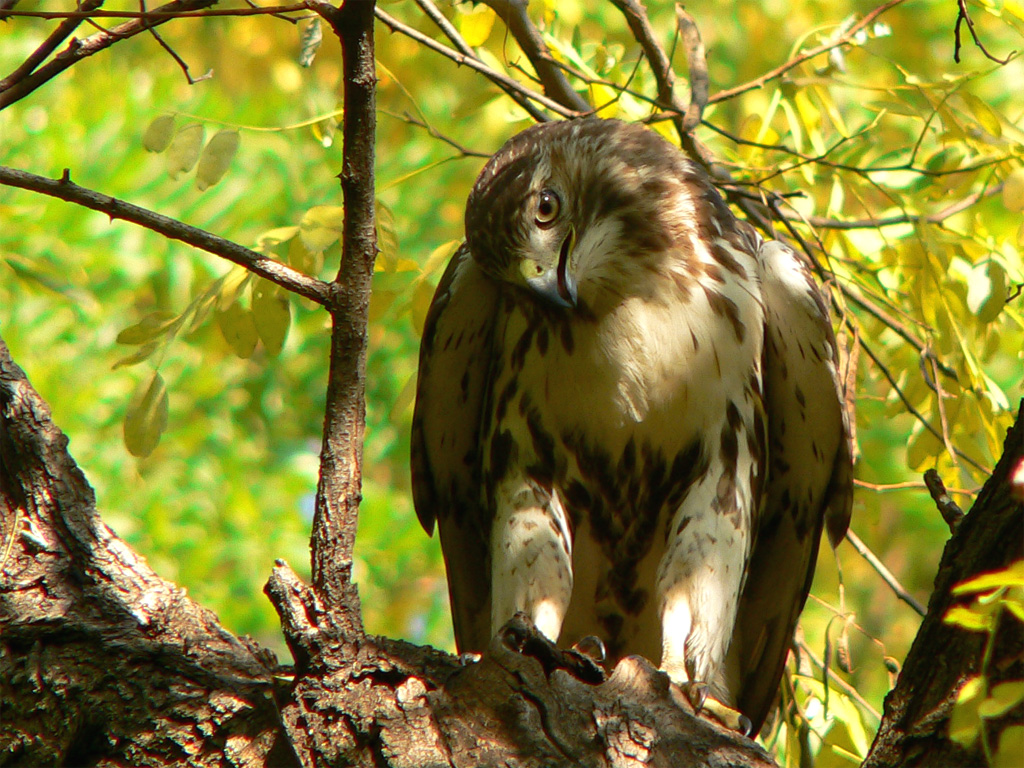Red-tailed Hawk (Buteo jamaicensis)

Great Lawn, Central Park, New York, NY, USA,07/12/2007.
© Kauser BHUIYAN. All rights reserved.
The Red-tailed Hawk (Buteo jamaicensis) is a bird of prey, one of three species colloquially known in the United States as the “chickenhawk,” though it rarely preys on standard sized chickens. It breeds throughout most of North America, from western Alaska and northern Canada to as far south as Panama and the West Indies, and is one of the most common buteos in North America. Red-tailed Hawks can acclimate to all the biomes within their range. There are fourteen recognized subspecies, which vary in appearance and range. It is one of the largest members of the genus Buteo in North America, typically weighing from 690 to 1600 grams (1.5 to 3.5 pounds) and measuring 45–65 cm (18 to 26 in) in length, with a wingspan from 110 to 145 cm (43 to 57 in). The Red-tailed Hawk displays sexual dimorphism in size, with females averaging about 25% heavier than males.
The Red-tailed Hawk occupies a wide range of habitats and altitudes, including deserts, grasslands, coniferous and deciduous forests, tropical rainforests, agricultural fields and urban areas. It lives throughout the North American continent, except in areas of unbroken forest or the high arctic. It is legally protected in Canada, Mexico and the United States by the Migratory Bird Treaty Act.
Because they are so common and easily trained as capable hunters, the majority of hawks captured for falconry in the United States are Red-tails. Falconers are permitted to take only passage hawks (which have left the nest, are on their own, but are less than a year old) so as to not affect the breeding population. Adults, which may be breeding or rearing chicks, may not be taken for falconry purposes and it is illegal to do so. Passage red-tailed hawks are also preferred by falconers because these younger birds have not yet developed adult behaviors, which will make training substantially more challenging.

Great Lawn, Central Park, New York, NY, USA,29/10/2005.
© Kauser BHUIYAN. All rights reserved.
Description: A male Red-Tailed Hawk may weigh from 690 to 1,300 g (24 to 46 oz), with a mean weight of 1,030 g (2.3 lb), and measure 45–60 cm (18–24 in). A female can weigh between 900 and 2,000 g (32 and 71 oz), averaging 1,220 g (2.7 lb), and measure 48 to 65 cm (19 to 26 in) long. The wingspan can range from 105 to 141 cm (41 to 56 in) and, in the standard scientific method of measuring wing size, the wing bone is 33–44 cm (13–17 in) long. The tail measures 19–25 cm (7.5–9.8 in) in length. The exposed culmen was reported to average 2.5–2.7 cm (0.98–1.1 in) and the tarsus averaged 8.6–9 cm (3.4–3.5 in). As is the case with many raptors the Red-tailed Hawk displays sexual dimorphism in size, as females are up to 25% larger than males.
Red-tailed Hawk plumage can be variable, depending on the subspecies and the region. These color variations are morphs, and are not related to molting. The western North American population, B. j. calurus, is the most variable subspecies and has three color morphs: light, dark, and intermediate or rufus. The dark and intermediate morphs constitute 10–20% of the population.
Though the markings and hue vary across the subspecies, the basic appearance of the Red-tailed Hawk is consistent. Overall, this species is blocky and broad in shape, often appearing (and being) heavier than other Buteos of similar length. A whitish underbelly with a dark brown band across the belly, formed by horizontal streaks in feather patterning, is present in most colour variations. Especially in younger birds, the underside may be otherwise covered with dark brown spotting. The red tail, which gives this species its name, is uniformly brick-red above and light buff-orange below. The bill is short and dark, in the hooked shape characteristic of raptors, and the head can sometimes appear small in size against the thick body frame. They have a relatively short, broad tails and thick, chunky wings. The cere, the legs, and the feet of the Red-tailed Hawk are all yellow.
Immature birds can be readily identified at close range by their yellowish irises. As the bird attains full maturity over the course of 3–4 years, the iris slowly darkens into a reddish-brown hue. In both the light and dark morphs, the tail of the immature Red-tailed Hawk are patterned with numerous darker bars.
Taxonomy: The Red-Tailed Hawk is a member of the genus Buteo, a group of medium-sized raptors with robust bodies and broad wings. Members of this genus are known as buzzards in Europe, but hawks in North America.
There are at least 14 recognised subspecies of Buteo jamaicensis, which vary in range and in coloration.

Carnegie Hill, Central Park, New York, NY, USA,19/02/2005.
© Kauser BHUIYAN. All rights reserved.
Distribution and habitat: The Red-tailed Hawk is one of the most widely distributed hawks in the Americas. It breeds from central Alaska, the Yukon, and the Northwest Territories east to southern Quebec and the Maritime Provinces of Canada, and south to Florida, the West Indies, and Central America. The winter range stretches from southern Canada south throughout the remainder of the breeding range.
Its preferred habitat is mixed forest and field, with high bluffs or trees that may be used as perch sites. It occupies a wide range of habitats and altitudes, including deserts, grasslands, coastal regions, mountains, foothills of mountains coniferous and deciduous woodlands, tropical rain-forests, agricultural fields and urban areas. It is second only to the Peregrine Falcon in the use of diverse habitats in North America. It lives throughout the North American continent, except in areas of unbroken forest or the high Arctic.
The Red-tailed Hawk is widespread in North America, partially due to historic settlement patterns, which have benefited it. The clearing of forests in the Northeast created hunting areas, while the preservation of woodlots left the species with viable nest sites. The planting of trees in the west allowed the Red-tailed Hawk to expand its range by creating nest sites where there had been none. The construction of highways with utility poles alongside treeless medians provided perfect habitat for perch-hunting. Unlike some other raptors, the Red-tailed Hawk are seemingly unfazed by considerable human activity and can nest and live in close proximity to large numbers of humans. Thus, the species can also be found in cities, where common prey such as rock pigeons and brown rats may support their populations. One urban Red-tailed Hawk, known as “Pale Male”, became famous for being the first Red-tail in decades to successfully nest and raise young in the crowded New York City borough of Manhattan.
